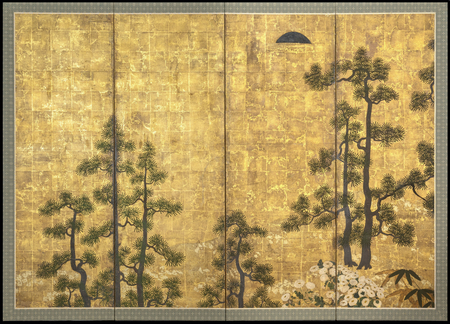Product Description
6342 A four-fold paper screen painted in ink and colour on a gold ground. The natural scene shows maki (Japanese umbrella-pine), kiku (chrysanthemum) in moriage (raised design), sasa (dwarf bamboo) on a knoll delineated by a subtle change in the colour and technique of the gold leaf. In the distance a moon rendered in silver leaf appears through the clouds.
Japan 16th century Muromachi/Momoyama period
Dimensions: H. 164.5cm x W. 229cm (65″ x 90¼”)
Maki or Koyamaki (Japanese umbrella-pine) is a unique conifer endemic to Japan and its name comes from the sacred Mount Koya, a huge temple settlement in present Wakayama prefecture. It can be used as an esteemed alternative to flowers offered to Buddha. Koyamaki have ancient associations with religious rituals and also have distinguished scent which is believed to remove negative vibrations and purify spirits. The conifer also remains green and fresh even during winter and is seen as a symbol of longevity and vitality.
Japanese interest in kiku (chrysanthemum) as a theme for poetry and cultural activities developed during the Heian period. At that time, with the evolution of a native artistic sensibility heavily influenced by the passing seasons, the flower gained its place as one of the premier symbols of autumn. Since then, chrysanthemum have long been one of the most popular subjects in Japanese paintings and works of art.
The sun and moon are occasionally depicted on pairs of screens in Japan and several examples as early as the 16th century are known to survive. It is especially notable that a six-fold screen housed in the Idemitsu Museum of Arts, Tokyo, depicts maki and the setting sun in a very similar manner as this present screen. The general style of maki, especially the delicate needles and claw-like branches and roots, of this screen resembles the pines in the Idemitsu screen in which the setting sun is also represented in a similar manner to the semi-circular moon depicted here. It is possible that the present screen was originally paired with the screen in the Idemitsu Museum or at least these screens may have been produced by the same atelier. For details about this similar example and the possibility that it was originally paired with another screen depicting the moon, see: Taizo Kuroda, et al., Worlds Seen and Imagined: Japanese Screens from the Idemitsu Museum of Arts, (New York, 1995) p.86, 87 pl.7.
For a comparable pair of screens with maki and the rising sun, attributed to Tosa Mitsumochi (act. circa 1523-1569), in the Okayama Prefectural Museum collection, see: Tsuneo Takeda et al., Nihon byobu-e shusei (Japanese screen paintings), Vol.9 Four Seasons, (Tokyo, 1977), p. 82-83, no. 64-65.
For other 16th-century screens in pairs depicting the sun and the moon represented by gold and silver metal sheets, see:
Tokyo National Museum et.al. eds., Screen Paintings of the Muromachi Period: A Special Exhibition Held to Commemorate the 100th Anniversary of Kokka Magazine, (Tokyo, 1989), p.62-63, no. 14., ‘Landscapes with the Sun and the Moon’ (16thcentury, Muromachi period) in the Tokyo National Museum (Important Cultural Property, item number A-1065);
Id. p.38-41, no. 7.; Suntory Museum of Art et.al. eds., Biombo: Japan Heritage as Legend of Gold, (Japan, 2007), p.55-57, pl.7., ‘Birds and Flowers of the Four Seasons with Sun and Moon’ (16th century, Muromachi period) in the Idemitsu Museum, Tokyo.









